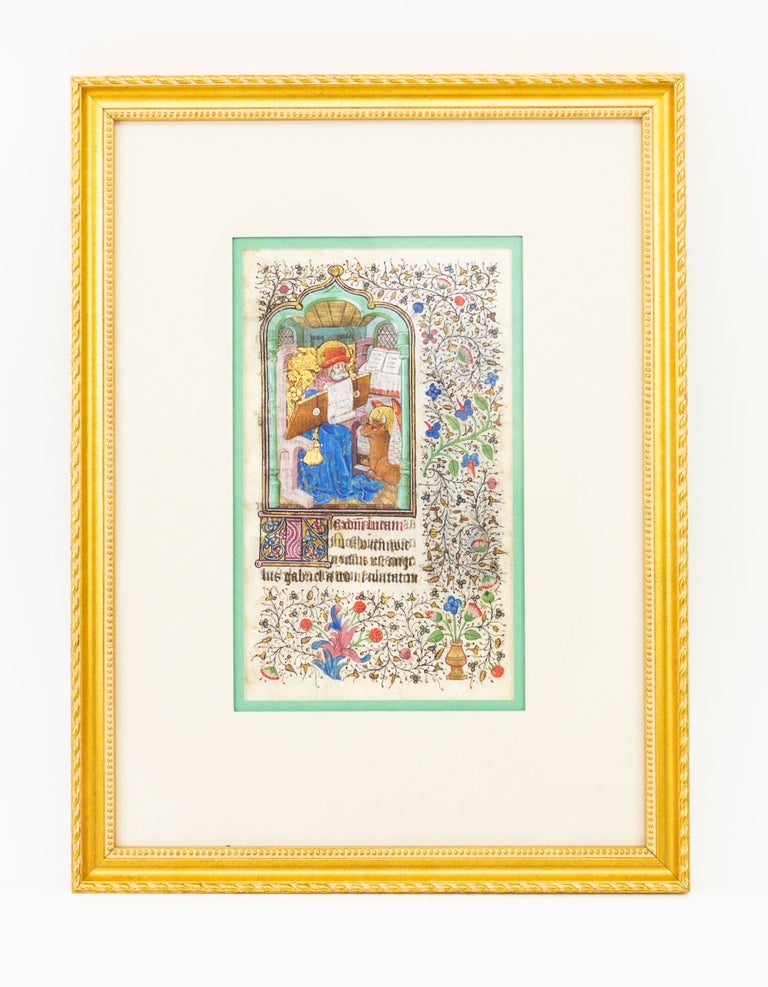
Browse Similar Items
TEXT FROM THE GOSPEL LESSONS.
(France [probably Besançon]: 3rd quarter of 15th century). Leaf: 239 x 165 mm. (9 3/8 x 6 1/2"). Frame: 365 x 275 mm. (14 3/8 x 10 7/8"). Single column, recto with four lines (beneath the miniature) in an elegant gothic book hand.
In a handsome gilt frame. Recto with rubrics in dark pink, one three-line initial in pink with white tracery, decorated with painted vines and on a gold ground, with A HALF-PAGE MINIATURE OF ST. LUKE IN HIS STUDY accompanied by his evangelist symbol (an ox with a nimbus and wings), in a thin, arch-topped gilt frame, SURROUNDED BY A THREE-QUARTER RINCEAU BORDER consisting of many hairline vines terminating in gold bezants and ivy, colorful acanthus, berries, a flower arrangement in a vase, and several other kinds of single flowers and floral sprays. ◆Vellum with slight cockling and light soiling, miniature with a little rubbing and a few areas of chipped paint (more noticeable in the blue robes and white writing surfaces and cloth), writing from verso visible behind text of recto (and faintly visible in the miniature) due to the thinness of the vellum, but none of these faults significantly affecting the overall appeal or cohesiveness of the image, and on the whole still a very attractive and richly painted miniature with handsome decoration.
With a pleasing palette, many fine details, and handsome border decoration, this splendid leaf from an unusually large Book of Hours opens the second Gospel Lesson with a depiction of Luke diligently writing in his study. As Roger Wieck eloquently states, the Gospel Lessons "offered one of the very few ways that late medieval Christians could actually possess the New Testament word of God (households did not own Bibles). . . . Appearing at the front of the Book of Hours, they form its foundation, the legitimizing structure upon which the rest of the prayers that follow are built. They helped, too, transform for its possessor the Book of Hours from a collection of texts into a sacred object." ("Painted Prayers," p. 40) The artist of the present miniature has enriched the scene with details emphasizing Luke's role as scribe and author: not one, but two writing surfaces are represented here (a long scroll spilling over the slanted writing desk and an open codex on display behind Luke’s evangelist symbol, the ox). Luke, intently focused on his work, holds a knife and quill (the latter to write and the former to sharpen the quill, steady the vellum, and scrape away any mistakes). A long, slanted writing desk with an attractive wood grain lays prominently across a throne-like chair, and two weighted straps (used to hold the scroll or leaves in place as the scribe wrote) can be seen dangling over its edge. The thoughtfully rendered interior includes a dramatic gilt brocade cloth across the back of the chair, a wooden ceiling with beams to suggest depth, and a set of pale green columns supporting an archway that frames the entire scene. Stylistically, this leaf can be localized to the Franche-Comté region in eastern France, and is closely related (if not directly attributable) to an atelier specializing in Books of Hours made for the Use of Besançon and most likely situated in that city (see Avril and Reynaud p. 197). The similarities are especially apparent in the figures' faces, which are slightly puffy in appearance and have distinct, slit-like eyes. As noted by Avril and Reynaud, the unnamed master of this atelier was deeply indebted to the Master of Morgan 293, a talented Burgundian illuminator active in the second quarter of the 15th century, whose name derives from a particularly lovely Book of Hours made for the Use of Besançon. In fact, the face of Luke in the present miniature greatly resembles that of Luke in the Morgan manuscript, and many of the details in our image accord with the Matthew miniature in that same manuscript: both contain a similarly shaped chair with a luxurious cloth back, a writing desk with wood grain, a scroll hanging over the desk, weighted straps, writing implements, a gilt pouch or tassel hanging from the Evangelist's robes, a wooden ceiling with beams, and architectural framing. Regardless of the identity of the artist, our miniature is an excellent example of a distinct regional style and offers the viewer multiple sources of pleasure in its richly detailed interior and attractive design, delicately framed and perched within an animated field of rinceau decoration in the surrounding borders. (ST17060BB)
Price: $7,000.00
